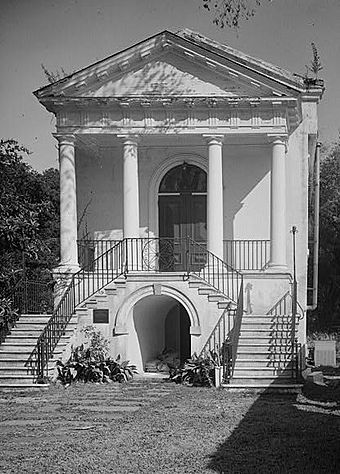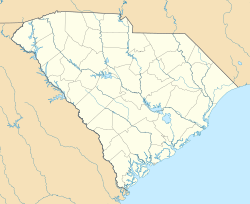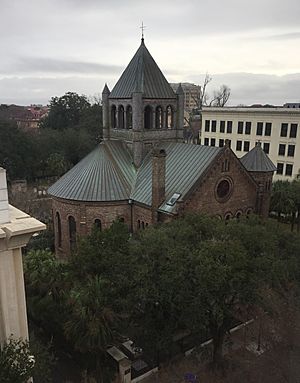Circular Congregational Church facts for kids
|
Parish House of the Circular Congregational Church
|
|
|
U.S. National Historic Landmark District
Contributing Property |
|

Parish House of the Circular Church
|
|
| Location | 150 Meeting Street, Charleston, South Carolina |
|---|---|
| Built | 1870 (parish house) 1892 (church) |
| Architect | Robert Mills (parish house) Stephenson & Greene (church) |
| Architectural style | Greek Revival, Romanesque |
| Part of | Charleston Historic District (ID66000964) |
| NRHP reference No. | 73001683 |
Quick facts for kids Significant dates |
|
| Added to NRHP | November 7, 1973 |
| Designated NHL | November 7, 1973 |
| Designated NHLDCP | October 9, 1960 |
The Circular Congregational Church is a historic church at 150 Meeting Street in Charleston, South Carolina. Its congregation, or group of members, was first formed way back in 1681.
Next to the church is a special building called the Parish House of the Circular Congregational Church. It was designed by the famous architect Robert Mills, who also designed the Washington Monument. Because of its beautiful Greek Revival style, the Parish House is a U.S. National Historic Landmark.
Contents
The Church's Long History
How It All Began
The church was started between 1680 and 1685 by some of the first settlers of Charles Towne (now Charleston). These settlers included English Congregationalists, Scots Presbyterians, and French Huguenots. At the time, the main church was the Church of England, so these groups were called "dissenters" because they had different beliefs.
They built their first church, called a Meeting House, on the same spot where the church stands today. The street was even named "Meeting House Street" after it, which was later shortened to Meeting Street.
In the early days, the church didn't have one official name. People called it Presbyterian, Congregational, or Independent. The church welcomed people from different Protestant groups. Many of its first ministers came from Scotland, England, and New England.
A Center for Freedom
The church and its members became strong supporters of freedom. Before the American Revolution, the British colonial government didn't treat "dissenters" very well. This made the church a place where people talked about independence.
A famous minister named William Tennent traveled across South Carolina in 1775. He encouraged people to support the cause of American independence.
The Revolutionary War
During the siege of Charleston in 1780, the church was hit by a British cannonball. When the British army took control of the city, they punished the church for supporting freedom. Many members were sent away from their homes.
The British used the empty, damaged church as a hospital or a warehouse. After the war ended, the members who were left in Charleston began to rebuild their church right away. By 1787, the congregation had grown so much that they built a second meeting house on Archdale Street.
The Famous Round Church
By 1804, the congregation decided to build a bigger and better church on Meeting Street. A member named Martha Laurens Ramsay suggested making it circular. The famous architect Robert Mills designed the new building.
The church he designed looked like the Pantheon in Rome. It was a huge round building, 88 feet across, with seven large doors and 26 windows. It was one of the first major domed buildings in North America and could hold 2,000 people.
However, the round church didn't have a steeple, and some people made fun of it with a rhyme:
Charleston is a pious place
And full of pious people
They built a church on Meeting Street
But could not raise the steeple.
The church members finally stopped the jokes in 1838. They added a tall, New England-style steeple that stood 182 feet high. After this, everyone started calling it the "Circular Church."
From Greatness to Destruction
From 1820 to 1860, the Circular Church was very popular. It had a large congregation that included both white and black members. In 1816, the church started the first Sunday School in South Carolina for religious education.
But on December 11, 1861, a massive fire swept across Charleston. The fire destroyed the beautiful round church building, leaving only ruins. The American Civil War followed, which was a difficult time for the city and the church.
In 1867, the black members of the church formed their own congregation, the Plymouth Congregational Church. The members of Circular Church began to rebuild their sanctuary in 1888, and the new building was finished in 1890.
The Church Today
The current church building is not perfectly round like the old one. It has a shape like a cloverleaf. But it is still called the Circular Church in honor of its famous past. It was built using some of the bricks from the old, fire-damaged church.
The church is known for helping the community. It has started programs to help families, provide comfort to the sick, and offer shelter to the elderly. It also provides space for many community groups that help people in need.
Today, the church welcomes everyone. Visitors can explore the historic grounds and learn more about its amazing story.
Gallery
See also









